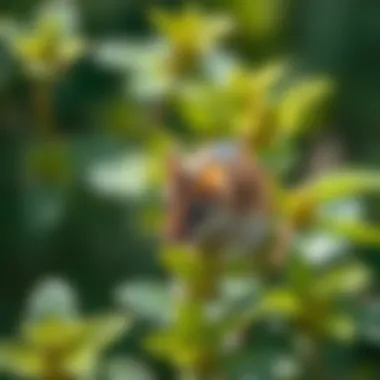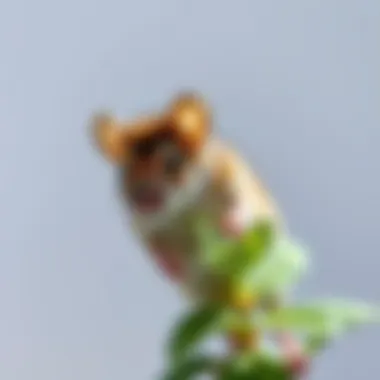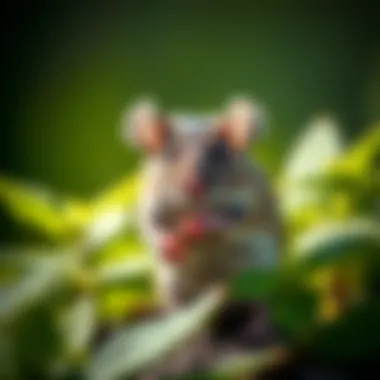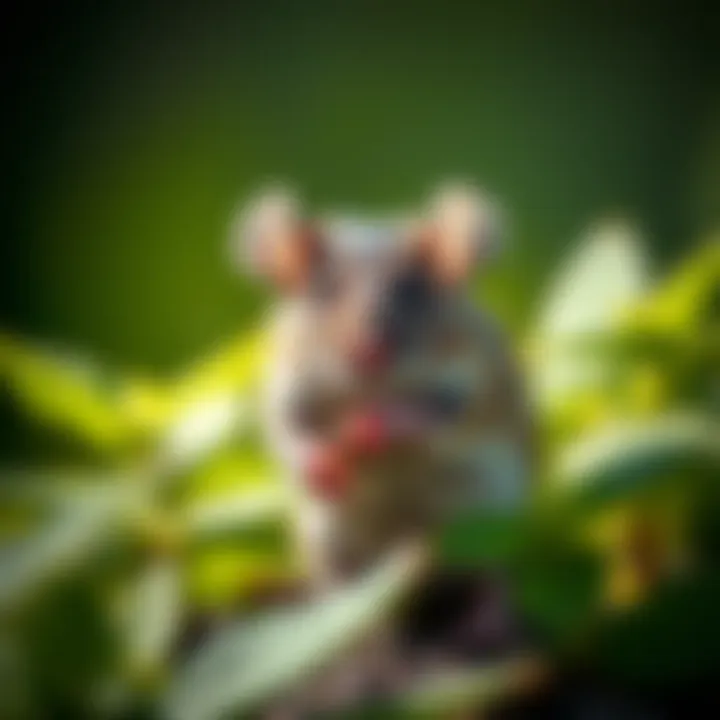Mint: A Natural Approach to Repelling Mice Effectively


Intro
Pest control can be a thorn in the side for many homeowners, especially when it comes to mice. These little critters can wreak havoc in homes, chewing through wires and contaminating food. Instead of turning to chemical solutions that might do more harm than good, it's worth exploring natural repellents—like mint. This article aims to dive into the effectiveness of mint as a mouse deterrent, discussing its properties, practical applications, and how it stacks up against other pest control methods. If you're a homeowner looking for sustainable solutions, this guide will walk you through everything you need to know about using mint to keep your home mice-free.
Pest Identification
Before galloping into solutions, it's crucial to know who you're up against. Mice can be sneaky little devils, but understanding their characteristics helps in managing them effectively.
Common Mice Species
- House Mouse (Mus musculus): This is the most common type, usually brown or gray. They are quite adaptable, thriving in urban settings.
- Field Mouse (Apodemus sylvaticus): Slightly larger, these mice prefer the outdoors but can invade homes when food is scarce.
- Deer Mouse (Peromyscus maniculatus): Recognizable by their bi-colored tails, these mice can be found in fields and forests but can also invade residences.
Signs and Symptoms of Infestations
Knowing the signs of an infestation means you can act fast.
- Droppings: Tiny, dark pellets in kitchens or along walls.
- Gnaw Marks: Chewed furniture, wires, or food packages.
- Nests: Shredded paper or fabric in hidden areas.
- Noises: Scratching sounds in walls or ceilings, especially at night.
Identifying these signs allows homeowners to formulate an effective action plan sooner rather than later.
Prevention Strategies
If you want to keep mice at bay before they make themselves at home, it’s all about prevention.
Home Maintenance Tips for Pest Prevention
- Seal Entry Points: Mice can enter through small holes. Use caulk to fill gaps around doors, windows, and foundations.
- Proper Food Storage: Keep food in airtight containers and avoid leaving crumbs on countertops.
- Declutter: Mice love hiding places; decluttering your space can minimize these opportunities.
Natural Deterrents and Barriers
Mint isn't the only option here, but it is one of the most pleasant-smelling options. Consider these methods as well:
- Essential Oils: Besides mint, peppermint oil also works. A few drops in cotton balls around entry points can send mice scurrying.
- Herb Plants: Growing mint plants indoors or outdoors serves a dual purpose: they smell delightful and deter pests.
- Other Strong Scents: Some folks find that strong scents like vinegar or citrus can also keep mice away.
Treatment Options
Once you’ve got a mouse problem, it’s time to act. The best approach can vary.
Overview of Chemical vs. Natural Treatments
While chemical treatments can be effective, they often come with risks to pets and humans. Natural solutions, like mint, offer a safer alternative without the scary side effects.
Step-by-Step Guides for DIY Treatments
Using mint to deter mice involves simple steps:
- Gather Materials: You’ll need fresh mint leaves, a blender, water, and a spray bottle.
- Prepare the Solution: Blend the mint leaves with some water until it’s a thick paste. You can add more water to make it liquid, depending on your preference.
- Strain the Mixture: To get rid of the solid bits, strain the mixture into your spray bottle.
- Apply: Spray areas where you've noticed mice activity, like corners, entry points, and their potential hideouts.
This mint-based solution not just repels mice but also leaves your home smelling fresher. Regular application will keep your place mice-free for longer.
"Natural solutions like mint can provide an effective and environmentally friendly way to deal with pesky mice."
Finale
Utilizing mint as a natural deterrent against mice presents a compelling case for homeowners committed to sustainable pest management. By understanding the pests, applying preventative strategies, and customizing treatments, it's possible to create a living environment that's as comfortable as it is safe. With these insights, homeowners can take control and effectively manage rodent populations without the need for harsh chemicals.
Intro to Mouse Infestations
Mouse infestations are more than just a nuisance; they pose potential health risks and damage to property. Understanding why these infestations occur sets the stage for investigating effective deterrents, such as mint. This article aims to shed light on the habits of mice, the consequences of their presence, and the natural strategies to manage them. While many might view mice as simply annoying little creatures, it’s crucial to recognize their impact on households. Their ability to reproduce rapidly and adapt to various environments contributes to their commonality in both urban and rural settings.
The Commonality of Mouse Problems
Mouse problems are hardly rare. One glance at pest control reports reveals that countless households grapple with these unwelcome visitors. Mice are clever and persistent, often entering homes through the tiniest openings. According to various studies, urban areas frequently report higher incidences of mouse infestations, largely due to dense populations and the abundance of food and shelter. Attics, basements, and kitchen areas tend to be hot spots for these critters, where they can thrive without being noticed.
- Seasonal Patterns: Mice often seek warmth during the colder months, prompting increased household sightings and complaints.
- Urban vs. Rural: While both settings experience mouse issues, the density of people in cities can lead to outbreaks that spread rapidly.
- Signs of Infestation: Look for droppings, gnaw marks, or nests to identify potential mouse problems early on.
Consequences of Mouse Infestations
Ignoring a mouse problem can lead to a series of unfortunate outcomes for homeowners. The repercussions extend beyond mere inconvenience, affecting the health of residents and the integrity of the home itself. Mice can contaminate food and surfaces with their droppings and urine, potentially spreading diseases such as hantavirus and salmonella. Moreover, they have a knack for chewing through wires and insulation, which poses fire hazards.


"If left unchecked, a small mouse problem can turn into a full-blown infestation, leading to costly repairs and health risks."
The connection between mice and both physical and mental stress is noteworthy. Many people find the mere thought of these creatures lurking in their homes unsettling. This anxiety can disrupt daily life, creating an ongoing feeling of unease.
In summary, understanding mouse infestations is vital, as it establishes the context for exploring effective deterrents like mint. By acknowledging the prevalence and consequences of these intrusions, homeowners can better appreciate the value of natural solutions in pest management.
Understanding Mice Behavior
Gaining insight into mice behavior is crucial when it comes to using mint effectively as a deterrent. Understanding how these creatures think, move, and live helps homeowners shape their pest management strategies. Each of these factors directly influences how and where mint might work best to keep these uninvited guests at bay.
Natural Habitat Preferences
Mice thrive in environments that offer them shelter, food, and water. They usually prefer spots that are warm, undisturbed, and close to their resource requirements. Attics, basements, and wall cavities are prime real estate for mice, providing cozy hideouts away from prying eyes. This means that if a homeowner wants to keep mice at arm's length, they need to understand these navigate their surroundings.
In a suburban setting, properties with overgrown shrubbery, stacked firewood, or cluttered basements can inadvertently become welcoming nests for these rodents. A little cleaning up can go a long way. Clearing vegetation around the house and ensuring that any potential nesting places are blocked off can help. After all, if mice can't find a comfortable home nearby, they're less likely to hang around.
Attraction Factors for Mice
Mice are not just casual wanderers; they are drawn to specific stimuli. Food sources are the biggest bait. Bread crumbs on the floor, open food containers, or pet food easily available creates an inviting buffet for them. It's also worth noting that mice have a keen sense of smell. They are attracted to the aroma of grains, cheese, and even fruit. Oftentimes, it's the smallest drop of food that can turn your serene kitchen into a bustling diner for mice.
Another key attraction factor is warmth. As the temperature dips, mice seek warmth to survive, often finding their way to our homes. Hence, sealing entry points becomes paramount. Mint can serve a dual purpose here: not only does it repel them, but it replaces attractants with an aroma they naturally avoid.
Sensory Perception in Mice
Mice experience the world through a set of finely tuned sensory perceptions. Their acute sense of smell allows them to sniff out food sources, while their tactile whiskers help navigate through tight spaces. Additionally, mice rely heavily on their hearing abilities. They can detect ultrasonic sounds which escape human perception. Understanding this sensory perception is key to knowing how to use mint effectively as a repellent.
Using strong-smelling mints, like peppermint, can disrupt their comfort zone. When mint is present, it overwhelms their sense of smell, prompting a retreat. This means that new scents in areas frequented by mice can act as warning signals. Therefore, positioning mint strategically around potential entry points will aid in reducing infestations.
"Understanding your enemy is the first step to managing it effectively."
In summary, by unraveling the behavioral patterns, habitat preferences, attraction factors, and sensory perceptions of mice, homeowners can craft a more nuanced approach to utilizing mint as a natural repellent. As we delve deeper into practical applications and homemade solutions, these insights will help illuminate the path to a mouse-free environment.
The Repelling Nature of Mint
Mint, with its crisp aroma, isn't just a culinary delight; it carries a weighty reputation among those dealing with pest issues, specifically mice. Understanding the repellent qualities of mint merits a discussion that dives deep into its characteristics, potential benefits, and the factors to consider when utilizing it effectively against rodent infestations.
Chemical Composition of Mint
Mint contains a potent blend of chemical compounds, particularly menthol and phenolic compounds, which are key players in its pest-repelling abilities. Menthol, the most notable constituent, is not merely a flavoring agent; it’s a compound that causes heat sensation—which is unpleasant and even irritative to mice. This sensory annoyance functions as a deterrent, signaling to mice that a space is inhospitable.
To harness the full potential of mint, it’s essential to understand how these compounds interact with mice's sensory receptors. The strong smell that humans may find refreshing can overwhelm the more sensitive olfactory system of rodents, effectively pushing them away from treated areas. In essence, the potency of mint is rooted in its natural chemistry, making it a fascinating subject for both homeowners and pest control professionals.
The Biological Response of Mice to Mint
Mice, like many creatures in the animal kingdom, are motivated by survival instincts, particularly when it comes to finding safe, comfortable habitats. This is where their biological responses to mint come into play. Research indicates that when exposed to mint scent, mice may exhibit behaviors like avoiding the area or displaying signs of distress. Their initial reaction is to explore—an instinctive trait—but upon facing the overwhelming sensation from mint, they often scurry away.
Interestingly, studies reveal that high concentrations of mint not only repel mice but may alter their behavioral patterns, causing them to seek alternative environments. This natural avoidance mechanism surfaces due to the mint's sharp scent which can overpower their typical exploratory and curiosity-driven behavior. Ultimately, leveraging this natural aversion can serve as an effective strategy in pest management—laying down sprays or planting mint in key problem areas can mitigate infestations.
Comparative Analysis with Other Natural Repellents
When juxtaposed against other natural repellents like cayenne pepper or citronella, mint holds its ground firmly not just in potency but also in practicality. For instance, cayenne may deter some vermin due to its spice but could attract other pests or even create unpleasant residues. Citronella, known for its insect-repelling properties, lacks the same effectiveness when it comes to mice. While these alternatives have their own merits, they do not quite match mint’s dual role as both a repellent and a refreshing addition to your garden.
Moreover, mint is widely available and easy to cultivate, which can not only elevate your home’s aesthetic but also make pest control a more sustainable endeavor. Homeowners can appreciate having a thriving mint plant that doubles as a pest management solution, rather than relying on potent chemicals that carry risks. Overall, mint stands as a beacon of natural pest control, showcasing that sometimes nature has the best solutions.
"Utilizing natural repellents like mint offers homeowners a pleasant-smelling solution that helps keep unwanted pests at bay."
Practical Applications of Mint in Pest Control
The use of mint as a natural repellent for mice offers a sustainable alternative to chemical pest control methods. Homeowners often grapple with the challenges of keeping their houses free from rodents. Mint not only provides an ecological solution but also brings with it a pleasant fragrance that many find appealing. The practicality of mint extends beyond mere aesthetics, as its properties can significantly minimize mouse presence in and around one’s home.
Methods of Application
Several effective methods can be employed to harness the power of mint in pest control. Implementing these techniques can make a noticeable difference in protecting one's living space from unwanted visitors. Among the most popular approaches are:
- Mint Oil Spray: Mixing a few drops of mint essential oil with water in a spray bottle creates a potent mixture. This spray can be applied to areas where mice are likely to enter or seek shelter. Regular application, especially in high-traffic areas, can enhance its effectiveness.
- Mint-Infused Cotton Balls: This method involves saturating cotton balls with mint oil and placing them strategically around the house—near entry points, nests, or common areas where mice usually roam. Changing these cotton balls every few weeks ensures that the scent remains strong.
- Fresh Mint Plants: Keeping potted mint plants around the house or in the garden not only repels mice but can also provide fresh leaves for culinary use. It's a two-for-one solution that combines aesthetics with functionality.
- Mint Sachets: Homemade sachets filled with dried mint leaves can be placed in drawers, cupboards, or garage spaces. They emit a refreshing scent that deters mice naturally without causing harm to the environment.
Implementing any of these methods is relatively straightforward and can fit seamlessly into a homeowner’s routine, making mint a practical solution.
Duration and Effectiveness of Mint Solutions


It's essential to understand that while mint is a formidable repellent, its effectiveness can wane over time. The longevity of mint solutions varies based on factors such as application technique, environmental conditions, and concentration of mint used.
- Duration of Scent: Mint oil generally holds its aromatic properties for a few days after application. Oil-infused methods, like the mint oil spray, may last longer in humid conditions compared to dry environments. To maintain effectiveness, it is advisable to reapply every week or bi-weekly.
- Effectiveness Against Mice: Research has shown that the strong scent of mint disrupts the sensory pathways of mice, making them less likely to inhabit treated areas. However, the application method matters; direct exposure to mint oil might be more effective than using dried leaves.
- Comparative Analysis: While mint is effective, it's worth noting that it may not completely eliminate an existing mouse infestation. It works best as a preventative measure or in conjunction with other pest control methods. For instance, using traps in conjunction with mint solutions can create a holistic approach to managing a mouse problem.
"Mint can reduce the likelihood of mouse intrusion, but its true strength lies in its use as part of a balanced pest management strategy."
Using mint-based solutions can be particularly beneficial for those sensitive to chemicals, and it aligns well with sustainability practices by reducing reliance on harmful pesticides. Ultimately, integrating mint into a pest control regimen can yield favorable results, offering peace of mind to house owners.
Homemade Mint Repellents
The use of homemade mint repellents is a practical and sustainable approach to keeping mice at bay. Many homeowners prefer using natural remedies, as they are often safer for both humans and pets when compared to commercial pesticides. Furthermore, mint has a notable track record in repelling mice due to its strong aromatic properties. This section delves into the specifics of creating effective mint-based solutions, their benefits, and considerations to keep in mind.
Recipe for Mint Oil Spray
One of the simplest and most effective forms of a homemade repellent is mint oil spray. Its preparation is fairly straightforward and requires minimal ingredients. The basic recipe includes:
- Ingredients:
- Instructions:
- 1 cup of water
- 1-2 teaspoons of peppermint essential oil (available at health stores or online)
- A clean spray bottle
- In a bowl, mix the water and peppermint oil together thoroughly.
- Pour the mixture into the spray bottle, ensuring it's properly sealed.
- Shake well before each use to ensure the oil is evenly distributed.
Once prepared, you can spray this mixture around entry points like windows, doors, and any cracks in the wall. The robust scent of peppermint tends to be irritating to mice and can effectively deter them from invading your home.
"Peppermint is not just for tea! This powerful oil is a natural way to create a barrier against unwanted pests."
Using Fresh Mint Leaves
The freshness of mint leaves can be another avenue worth exploring. Using actual leaves might seem quaint, but they can do a solid job at providing a deterrent. Here’s how to maximize their effectiveness:
- Placement Tips:
- Regular Maintenance:
- Crush fresh mint leaves (about a handful) to release their oils before placing them in strategic areas.
- Some effective locations to place crushed leaves include:
- Kitchen cabinets
- Under sinks
- Near pantry areas
- Replace the leaves weekly to maintain optimal scent strength.
- Try to keep the leaves slightly moist to enhance their oil release.
Fresh mint serves dual purposes: it adds a pleasant aroma to the home while simultaneously warding off mice. Additionally, refreshing your supply can become an engaging task, connecting you with the essence of your home.
By leveraging these homemade mint repellents—from simple mint oil sprays to the aromatic quality of fresh mint leaves—you can take decisive steps in creating a mouse-free environment while enjoying the sustainability of natural remedies.
Mint in Combination with Other Methods
Integrating mint with other pest control strategies not only enhances its effectiveness but also aligns with sustainable living practices. Utilizing mint in conjunction with various methods can maximize the deterrent experience against mice, creating barriers that they are less likely to cross. The combination can also help in addressing weaknesses that might exist when mint is used alone, making it a versatile ally in your home defense arsenal.
Integrating Mint with Traps
Incorporating mint with traps presents a smart strategy for a more holistic approach to pest management. Traditional traps, when paired with the invigorating scent of mint, may not only lure mice but also immediately repel others from frequenting the same area.
- Types of Traps to Use:
- Placement Strategy:
- Snap traps can be smeared with a touch of mint oil to amplify scents while attracting curious mice with food, ensuring that they get caught in the act.
- Live traps can be effective; consider placing mint leaves inside to entice but also deter other mice surveying the scene.
- Position traps in locations that have a history of rodent activity, such as near food sources or nesting sites. Adding mint will make it less appealing for the other mice to wander nearby.
Using mint in this way makes traps far more strategic — it becomes less about the catch and more about an environment that maintains a lower rodent profile.
Complementary Use of Essential Oils
Mint is just one essential oil in the rich pool of options available for pest deterrence. Combining mint with other essential oils can create a powerful offensive against mice.
- Popular Essential Oils to Combine:
- Peppermint Oil: A close cousin to standard mint, its strong aroma is a well-known mouse repellent. Mixing it with mint oil can create an even stronger scent barrier.
- Eucalyptus Oil: Known for its fresh scent, eucalyptus can be another layer of defense that masks the areas in which you suspect mice are entering.
"Combining mint with other essential oils not only amplifies repellent properties but also provides a pleasant aroma in your home."
- Application Techniques:


- Consider using a spray bottle to mix equal parts of mint and selected essential oils, diluted in water for easy use around entry points, corners, and other critical areas.
- Diffusing the combined aroma throughout the home may keep mice away, minimizing their motivation to enter.
Advantages and Limitations of Mint-based Solutions
Mint's allure is not just confined to its culinary uses; its role in pest control is gaining traction, particularly among homeowners keen on sustainable methods. This section delves into the benefits and considerations that come with using mint as a solution for deterring mice, providing a balanced view to inform potential users.
Sustainability and Safety
One of the key aspects that homeowners often prioritize is the sustainability of any pest control method used. Mint excels in this regard, presenting itself as a renewable and biodegradable option compared to chemical alternatives. The cultivation of mint requires less environmental scrutiny. Homeowners can opt to grow their own mint, enabling a green approach toward pest management. Not only does this provide a continuous supply of mint for various uses, but it also encourages a connection with nature.
Using mint is generally considered safe around children and pets, distinguishing it from harsher chemicals that can pose health risks. The organic compounds in mint, primarily menthol, offer a refreshing aroma while repelling rodents. This safety component appeals strongly to families who want to keep their homes free from harmful substances.
However, it is essential to apply mint solutions correctly. A miscalculation in concentration can undermine its effectiveness and potentially lead to over-saturation. Always consider the area of application, and prioritize proper usage to maintain that safety standard.
Potential Downsides
Despite its numerous advantages, it's crucial to weigh the limitations inherent to mint-based pest control. First and foremost, the effectiveness of mint as a repellent can vary significantly based on environmental factors. Some users report fluctuations in success, which might be influenced by the specific type of mint used or the infestation level present.
Another downside is the temporary nature of mint's effectiveness. As the aroma dissipates, which can happen within a few days, the need for frequent reapplication becomes apparent. While this does not imply that mint is a failed solution, it does necessitate a commitment to continuous use, which may not be appealing to everyone.
Furthermore, while mint may deter some mice, it is not a universal shield. Certain mouse species may be less affected, and there could be instances where mice simply adapt to the odor over time.
"Success in pest control often lies in a multi-dimensional strategy, blending renewable solutions with practical applications."
For more insights into pest management methods, you might explore resources like Wikipedia or look at practical tips shared on Reddit. These platforms often provide real-world experiences that can further guide your pest control journey.
Real-World Applications and Case Studies
Understanding how mint can be effectively used as a deterrent against mice in real-world scenarios is paramount in grasping its practical relevance. The topic of real-world applications is not merely about showcasing effectiveness; it involves exploring practical implications, success stories, and the experiences of homeowners and professionals in meandering through pest control challenges. Here, we deepen our understanding of how mint can serve as an effective strategy in rodent management and the benefits this approach holds.
Successful Use of Mint in Residences
The anecdotal experiences of countless households reveal the power of mint in warding off unwanted furry visitors. Many families have found that utilizing mint leaves or essential oils in targeted areas works wonders. Here are some efficacious actions taken by residents:
- Placement of Fresh Mint: Homeowners often place bundles of fresh mint leaves in areas where mice tend to roam. This includes under sinks, behind appliances, or near entry points. The strong scent of mint acts as a natural barrier.
- Mint Oil Soaked Cotton Balls: For those who prefer a more concentrated approach, saturating cotton balls with mint oil and placing them strategically can be quite effective. Residents report a noticeable reduction in mouse sightings when these are used in pantries and storage areas.
- Gardening with Mint: Some individuals go a step further by planting mint in their gardens or even pots indoors. The presence of mint not only beautifies a space but also creates a natural deterrent that keeps mice at bay.
The key takeaway is that consistent application is the secret ingredient to success. Homeowners share that a combination of freshness and regular replacement of mint materials ensures prolonged effectiveness.
Observations from Pest Control Professionals
Pest control professionals have also taken notice of the increasing interest in mint as a natural solution. Their insights shine a light on its practical usage, limitations, and effectiveness. Here are some pivotal observations from these experts:
- Efficacy in Initial Response: Many practitioners note that while mint is effective in the initial stages of a mouse infestation, it should ideally complement other methods. Practitioners evaluate that mint works well alongside traps and bait but shouldn't be the sole means of control.
- Chemical Sensitivity Considerations: Experts emphasize that some clients may have allergies or sensitivities to mint or its oils. This nuance is critical to consider when suggesting any natural pest management solution.
- User Education: Professional pest controllers often educate homeowners on how to maximize mint's potential. This includes instructions on proper application, maintenance, and when to seek further assistance if mint alone isn't curbing the problem.
To sum it up, while mint alone may not be a catch-all solution, it holds significant promise as an eco-friendly measure, especially when utilized in conjunction with tried-and-true pest control strategies.
For further information on natural pest control and insights into the efficacy of mint, you might check these resources:
- University of California Pest Management
- American Pest Control Association
- Pest Control Strategies on Reddit
Ending
As we wrap up our exploration into the use of mint as a natural deterrent for mice, it’s crucial to reflect on a few key elements that highlight the significance of this topic. Mint stands out as a sustainable and eco-friendly solution that offers various benefits in rodent management. It’s not just about chasing away mice; it’s about fostering a cleaner environment that's conducive to both human comfort and health.
First, it’s important to recognize that mint’s aromatic properties can be more than a simple repellent—it creates a sensory barrier that mice find uncomfortable. This is rooted in their biological repulsion to certain scents, specifically the strong, pungent aroma of mint. Such natural avoidance behavior is beneficial not just for homeowners but also for pest control professionals seeking alternatives to chemical solutions.
Moreover, using mint aligns with broader trends in sustainable living, appealing to homeowners who prioritize environmentally friendly options over synthetic pesticides. It promotes a lifestyle that respects nature and encourages the use of non-toxic solutions for common household challenges.
"Using natural solutions like mint can not only deter mice but also enhance the overall ambiance of your home with its fresh scent."
However, while mint solutions are effective, they may not be foolproof. As we noted throughout the article, integrating mint into a broader pest management strategy is necessary. It’s a tool to be used alongside other methods, emphasizing the importance of a comprehensive approach to pest control.
In summary, the impact of identifying and utilizing effective, natural deterrents cannot be overstated. The benefits of mint in rodent control extend beyond mere repulsion to include ecological and health considerations. By embracing such strategies, homeowners can look forward to a pest-free environment without compromising their values or health. As we move forward, it is essential to keep the conversations around natural pest control alive to promote awareness and further innovation in this field.
Summary of Findings
In our discussion about mint as a natural solution for deterring mice, several findings emerged:
- Mint’s Repellent Properties: The strong odor associated with mint plants is unappealing to mice, leading them to avoid areas where mint is present.
- Diversity of Application: From sprays made with mint oil to the simple placement of fresh mint leaves, there are multiple ways to incorporate this herb into pest management strategies.
- Sustainable and Safe: Mint offers an eco-friendly alternative to conventional rodenticides, promoting safety for humans and pets alike.
- Real-world Effectiveness: Case studies illustrate that many homeowners have reported success in reducing mouse activity through the use of mint-based methods.
Future Directions in Pest Management
Looking to the future, there are several exciting avenues in pest management that can be explored further, particularly with respect to mint and other natural solutions:
- Research on Efficacy: Continued research is essential to quantify the effectiveness of mint in various settings. This could include differing climates, household designs, and mouse species.
- Integration with Technology: Innovations could blend traditional methods with modern technology, like scent dispersal systems that constantly allow mint to deter pests.
- Education and Awareness Campaigns: As society increasingly gravitates towards natural solutions, educational programs can help populations understand the benefits and proper usage of mint in pest management.
- Exploration of Other Natural Repellents: Investigating other herbal solutions alongside mint can expand the toolkit available for homeowners and professionals alike.
Ultimately, positioning mint as part of a larger strategy in rodent management honors its roots in environmental consciousness while addressing practical pest control needs. It opens the door for further inquiry, yielding potentially groundbreaking perspectives on sustainable pest solutions.



